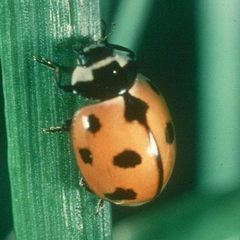
|
Welcome to the Search for Lost Ladybugs!!Over the past twenty years several native ladybug species that were once very common have become extremely rare (see details on the nine spotted ladybug pictured left and the two spotted too). During this same time several species of ladybugs from other places have greatly increased both their numbers and range. Besides being incredibly cool and charismatic ladybugs are also essential predators in both farms and forests that keep us from being overrun with pests (like aphids and mealybugs). In many areas the native ladybugs are being replaced by exotic ones. This has happened very quickly and we don't know how this shift happened, what impact it will have (e.g. will the exotic species be able to control pests as well as our familiar native ones always have) and how we can prevent more native species from becoming so rare.
|
What can I do to help? - Find 'em and shoot 'emTo be able to help these and other ladybug species scientists need to have detailed information on which species are still out there and how many individuals are around. Entomologists at Cornell can identify the different species but there are too few of us to sample in enough places to find the really rare ones. We need you to be our legs, hands and eyes. If you could look for ladybugs and send us pictures of them on Email we can start to gather the information we need. We are very interested in the rare species but any pictures will help us. Heres how the program will work: 1. Go out and look for lady beetles (see tips below and check out our handy Field Guide ) 2. When you find a ladybug - shoot it! (with a digital camera - see tips below).
3. Send the digital image to Ladybeetle@ento.cornell.edu along with the time, date, location, and habitat (e.g. garden, wild field, corn field etc.)
Where and when to look for ladybugs: The best time to look will be between May and October.
Prime season will vary according to your local climate. The best places to look will be on or around
lush plant growth (especially if there are aphids). If you have access and permission, agricultural
fields can make excellent collecting sites. Crops that are known to harbor many ladybugs include forage
fields like alfalfa or clover and grains like wheat and corn before it gets too tall. Be sure to get
permission from the grower first and make sure that the field has not been recently sprayed with chemicals.
Other types of plants like wild flowers, weeds and even trees and shrubs can be home to many ladybugs too.
How to collect ladybugs: The best collection method will depend on the habitat. For softer plants like
grasses, weeds or flowers you will catch more if you use a sweep net. A sweep net is essentially a tough cloth
bag on a metal ring attached to long handle. By sweeping your net back and forth through the plants you knock
them off and they land in your net. You can either build your own net (see tips from the
American Museum of Natural
History - be sure to use strong wire and fabric) or you can buy sweep nets
(Bioquip). If you do use a sweep net you will probably
want to divide into two groups with one group "sweeping" and then dumping what they find into a
bin or onto a sheet for the other group to catch and place in containers. For tough, thorny, or woody plants
you can carefully grab the ladybugs or tap them into a jar. Alternatively you can lay a sheet below the
bush or tree and "beat it" (not too hard!) with a stick or dowel and then collect the ladybugs as
they fall onto the sheet.
Draw your own ladybug A high-quality black and
white outline of a ladybug that you can color in to match your favorite ladybug.
|